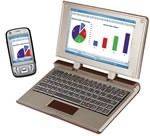 Maybe I should have waited a few more weeks to write that article about how the smartphone platform is developing into a mobile computing platform. I said that it could be months before we see any sort of reality but today Qualcomm have demonstrated an Inventec OEM mini-laptop running on a Snapdragon ARM-core processor.
Maybe I should have waited a few more weeks to write that article about how the smartphone platform is developing into a mobile computing platform. I said that it could be months before we see any sort of reality but today Qualcomm have demonstrated an Inventec OEM mini-laptop running on a Snapdragon ARM-core processor.
There aren’t any pics available at the moment but the notebook is said, in this article from PC World, to be "small and streamlined." Not surprising because Nvidia also showed their new Tegra platform sitting inside an EEE PC casing today and apparently the complete motherboard was just 45mm x 45mm.
The most interesting thing though are comments related to Windows Mobile 7.
Microsoft Windows Mobile 7, which is made for chips used in mobile phones, will be more laptop friendly than older versions of Windows Mobile, said Luis Pineda, senior vice president at Qualcomm, on the sidelines of a news conference in Taipei.
Windows Mobile 7 could be a key for the mobile phone industry in the future if they hope to take a bite out of the growing market for mini-notebooks such as the Eee PC that have 7-inch to 10-inch screens, weigh less than 1 kilogram and connect wirelessly to the Internet.
I have no problem with a netbook running Windows Mobile 7 as long as the applications are as rich as they are on the desktop. I’m sure many others will be happy too and if the device does the job, for the same price but returns a much better battery life[1] ARM-based devices are going to have a lot of advantages.
Qualcomm are expecting device to be available before the end of the year.
[1] While these ARM-based CPUs run at lower power requirements, the biggest power drains on netbooks are actually screen backlighting, storage and radio power. Advantages for ARM-based devices in 2008 could be significant, offering an estimated double, in-use battery life. Towards the end of 2009 though, Intel is expected to have the Moorestown platform available which will narrow the margin to very small levels.











“Windows Mobile 7 vs. Ubuntu Mobile”. This is a topic to an article I would really love to read Chippy :)
I wonder why Intel MIDs will only have 2-3 hours of battery life when from what I’ve seen at ITT, the Nokia n8x0 tablets often get up to 5-6 hours from its tiny battery.
In theory, they should be using similar screen, storage and radio technology.
ones the programmers gets used to windows mobile on a larger screen, i dont see why a winmob app should be any less rich then the current desktop ones.
hell, the celio redfly that you have a image of there shows that the mobile office apps can make use of a larger screen area without trouble.
but in the end i guess it depends on what on think of as a richer app. imo, less is more ;)
So about WM apps being as rich as desktop apps. It is certainly possible however currently in today’s SDK its much more difficult to do a rich app in a CE based device than on Windows.
HOWEVER this is beginning to change with upcoming SDK’s for .NET Compact Framework & WM7 SDK’s.
You will see things like Silverlight running on Windows Mobile etc. Making rich apps portable from their desktop equivilents.
MS’s goal is to empower developers so that they can leverage this richness.
The problem is that there are few development tools for the Compact Framework. Visual Studio Express IMHO needs to support Windows Mobile.
Look at Apple, XCode is not only free but is bundled with OS X!
Windows mobile are simply great.. so no wonder these guys are taking them one step ahead. Thanx for the info